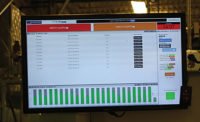PARIS—New 5G technology provides the ability to connect multiple devices at once and move more data faster than ever. During the next decade, it will transform the way that conveyors, fastening tools, robots and other production equipment interact in assembly plants. The technology will also drive numerous Industry 4.0 initiatives, improving the automation of production processes and real-time monitoring of machine conditions.
According to a recent study conducted by the Capgemini Research Institute, industrial 5G adoption is still in its infancy, with only about 30 percent of large companies having moved to the pilot stage or beyond.
Signaling a paradigm shift, 40 percent of industrial organizations surveyed expect to roll out 5G at scale at a single site within two years, and the experience of early adopters could persuade others to make the move.
Early implementations are already delivering strong business benefits, with 60 percent of early adopters saying that 5G has helped to realize higher operational efficiency, while 43 percent claim they have experienced increased flexibility.
The “Accelerating the 5G Industrial Revolution” study also found that manufacturers are optimistic that 5G will drive revenues by enabling the introduction of new products, services and business models. In fact, 51 percent of respondents plan to leverage 5G to offer new products.
“Industrial 5G is a key catalyst in unlocking the potential of intelligent industry and accelerating data-driven digital transformation,” says Fotis Karonis, group leader of 5G and edge computing at Capgemini. “Enterprises need to take advantage of the benefits of 5G by engaging with the ecosystem to tap into the shared expertise and cocreate innovative, sustainable solutions for tomorrow.
“Organizations need to determine the optimum network model, the right set of partners, and the most impactful use cases that fit their needs when implementing 5G,” explains Karonis. “Edge computing is viewed as a critical part of this strategy.”
However, numerous challenges remain before there will be widespread 5G use in factories, such as:
- Integrating 5G with existing networks and IT systems. Manufacturers are finding that the lack of standardized, interoperable systems result in increased time for assembly and testing.
- Defining 5G use cases and estimating their return on investment, especially in brownfield environments, where a return needs to be measured against existing options like wired connections and the cost of replacing cables.
- Managing cybersecurity due to difficulties in selecting trusted or qualified vendors, anticipating the security impact of different network deployment scenarios and a lack of internal processes to reduce exposure to risk. More than two-thirds (70 percent) of manufacturers surveyed by Capgemini view the management of cybersecurity as a key challenge associated with 5G implementation.







